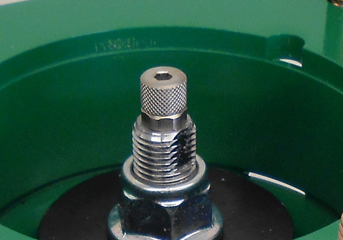I want to make my RSX quicker while also being more comfortable. I decided one way I could do this would be actively changing suspension dampening depending on a few factors, like braking, accelerating, turning, and road surface. There are products on the market that perform a similar function, but I'd like to improve on that formula.
My plan is to execute it with inexpensive and widely available parts to make actively adjustable suspension dampening a more affordable and open source option. I do have Tein Flex Z coilovers, so I'll be designing with that in mind, but I'll be making adapters for other single-adjustable coilover. I'm also designing this to be universally applicable for other cars with a simple 3D printed bracket change.
 |
| Tein Coilover Dampening Adjustment Knob |
Sales Pitch
If you're tired of the hassle of manually adjusting your suspension and compromising performance on varying terrain, then there's good news for you. With the latest advancements in technology, you can now have an automated suspension system that adjusts itself based on the road conditions you're driving on. Whether you're driving on a bumpy road or accelerating quickly, the system will adjust the suspension to optimize grip and provide a smoother ride.
This system also allows you to manually adjust the suspension to fine-tune the handling of your car. With a simple switch, you can change from automatic to manual mode, giving you full control over the suspension settings. Additionally, the system provides a manual bias mode that allows you to adjust the suspension on each corner of the car independently. This feature is especially useful when you want to experiment and find the best settings for a specific driving scenario.
With this technology, you'll no longer have to pull over your car, open the hood, and adjust the suspension manually. Instead, you can focus on enjoying your ride while the system does the work for you. So whether you're driving on a smooth track or a rough road, you can be confident that your car's suspension is optimized for the best performance possible.
Bill of Materials
 |
| NEMA 17 Stepper Motor |
4x "TwoTree" 4-Lead NEMA17 Stepper Motors 42BYGH (Comes with 5 so you have an extra)- I'll use 4 NEMA 17 stepper motors to spin the adjustment knob on each coilover. These you may recognize as 3D printer motors. They are fast, strong, and accurate enough to make this work.
- Chosen because 500 RPM = 8.6 full motor rotations / second.
- Rated for 80 degrees C or 176 degrees F. I'll have to protect them from moisture, but also make sure they're cool since under the hood gets hot, and they'll be working hard.
 |
| BigTreeTech TMC-2208 - Shown With Heatsink Attached |
4x TMC2208 Stepper Motor Drivers (Comes with 5 so you have an extra)- I'll use 4 TMC-2208 stepper motor drivers to silently actuate the motors quickly. I chose these because they were cheap and have a lot of interesting features. I could have gone with the TMC-2209, and maybe I eventually will as a drop-in upgrade, but these work.
- Up to 1.4A RMS, 2A Peak Coil Current
- 4.75V-36V DC
- UART (No Sense Resistors Required)
- No solder bridge required
- Comes with heatsinks
 |
| ADXL-345 - Shown Without Pins Soldered On |
2x ADXL-345 Accelerometers- I'll use 2 ADXL-345 accelerometers to measure forward and reverse motion, as well as vertical motion of the chassis. They will detect the speed of the car and send that data to the ESP-32.
- Multiple ranges (+-2G, 4G, 8G, and 16G)
- Low power consumption
 |
| ESP-32 30 Pin Version |
2x ESP-WROOM-32 (This comes with 3 so you have an extra)- I'll use 2 ESP-32 SOC's to handle processing sensor data and sending commands to move the motors. These are cheap, commonly available, low power system-on-chip devices (basically computers) that can handle all the data and communications duties. They're also easy to set up and program for.
- Bluetooth, Wifi, and plenty of pins to connect external devices.
- Low power.
- Programmable with C or MicroPython (I'll use the latter)
Project Plan
- I'm going to create drivers for the TMC-2208 and ADXL-345 in MicroPython to help our ESP-32 send and receive data with them.
- After I have this piece done, I'm going to connect the accelerometer circuit to the stepper motor circuit and prove that I can make the stepper motor move in accordance with sensible accelerometer data.
- The next step following that will be proving that I can control multiple stepper motors at the same time, and then use multiple accelerometer data together usefully.
- Then, I'll try to prove I can communicate between 2 ESP-32's.
- Following that, I need to 3D design brackets, cases, and motor keys to mount these to the car.
- Next comes testing and adjustment of the firmware to make it actually make the car faster.
- Finally, I'll write documentation, performance numbers, and make kits to provide to the community.
Concluding Notes
I hope you enjoy my progress on my adjustable suspension dampening system for the RSX. I'm hoping to make this accessible and usable on all other sorts of cars as well to open up the world of active suspension to everyone at an accessible price.
Don't be too intimidated by the level of difficulty I'm showcasing here, this is mainly documentation for me.
Once I get to the end of this project, I plan on compiling all the software into one easily installable package with instructions and 3D print .stl files for the brackets. I will also sell complete kits with everything already done for you, where you just need to bolt everything on and run power and ground wires.Disclaimer:
I may receive payment if you purchase products using my Amazon links. Thanks for helping keep the HID's on : )







